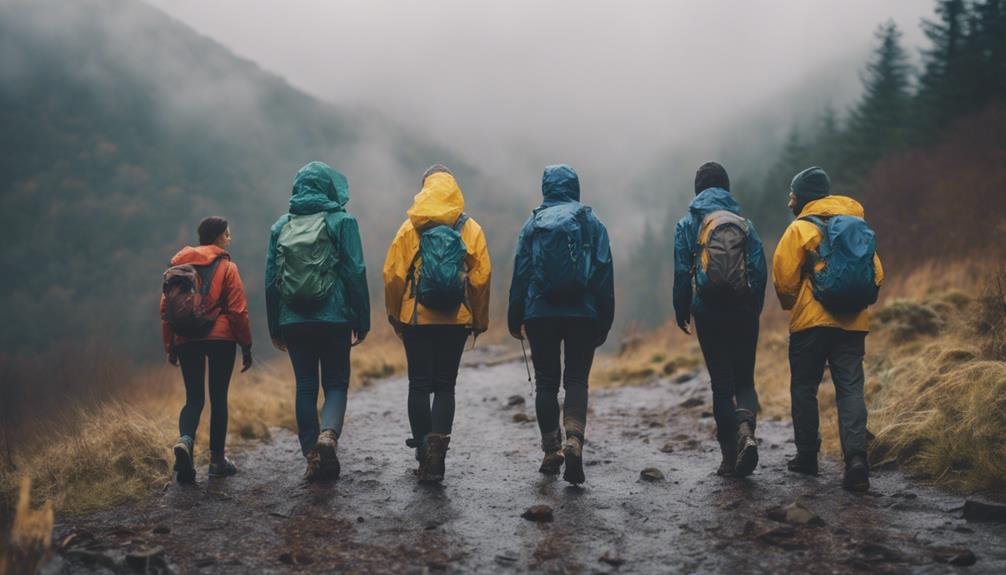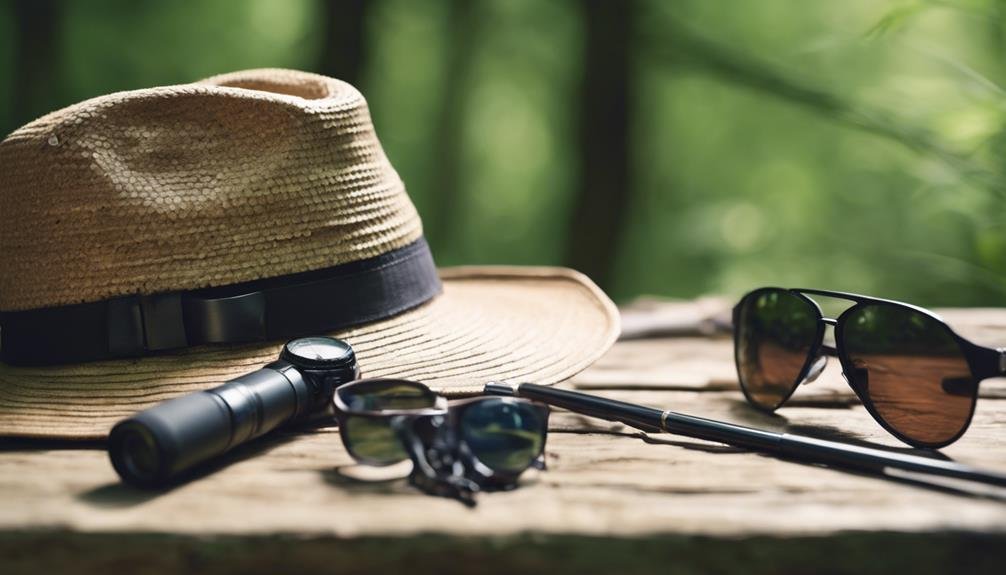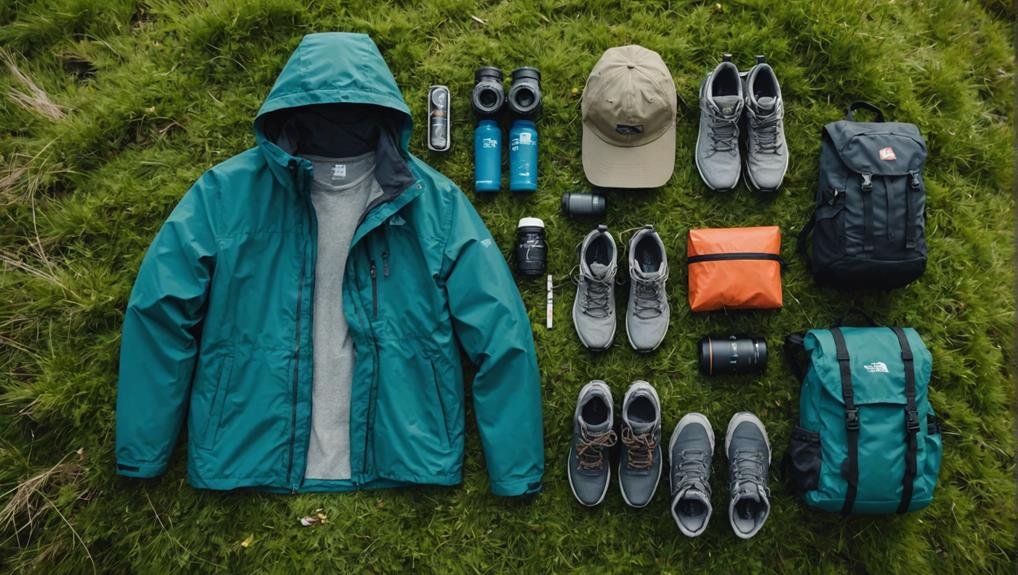Selecting the right base layer can’t be emphasized enough as you start hiking. Opting for materials like merino wool or synthetic fibers, which wick moisture and keep you dry, is a pivotal first step.
This choice might greatly impact your comfort as you encounter varying temperatures and conditions on the trail.
Are you curious about how these materials compare and which might best suit your specific needs? Explore the options and see how your initial selection could influence your overall hiking experience.
Key Takeaways
- Select a base layer of moisture-wicking materials like merino wool or synthetic fibers.
- Include an insulating layer, such as fleece or down, for temperature regulation.
- Choose a weatherproof outer layer with features like sealed seams and water resistance.
- Use appropriate footwear based on terrain, such as lightweight hiking shoes or waterproof boots.
- Invest in essential accessories like a hydration system, sunscreen, and UV-blocking sunglasses.
Choosing Your Base Layer

When starting your hiking adventure, choosing a breathable and moisture-wicking base layer is important to keep you comfortable. The right fabric types can make or break your experience as they are essential in moisture management, ensuring that sweat is quickly removed from your skin.
Materials like merino wool and synthetic fibers such as polyester are popular choices. Merino wool is excellent for regulating body temperature and naturally resists odor, while polyester is durable and dries quickly.
Avoid cotton as it tends to retain moisture, which can lead to discomfort and chafing during long treks. Consider the specific conditions you’ll be hiking in. A light, breathable fabric is essential for warmer climates to help you stay cool.
In cooler conditions, you might opt for a slightly thicker base layer that still offers good moisture management to keep you dry from internal sweat but doesn’t go into the realm of insulation, which is another layer entirely.
Lastly, make sure the fit is right. It should be snug enough to facilitate moisture wicking but not so tight that it restricts movement. A good base layer is foundational to a successful hiking outfit, setting the stage for trail comfort and endurance.
Importance of Insulating Layers
Adding an insulating layer is essential for maintaining heat during colder hikes. It traps warm air close to your body as a critical barrier against the chill. When you’re selecting this layer, consider various material types.
Fleece is popular for its lightweight and breathability, while down offers superior warmth but performs poorly if wet. Synthetic insulators, on the other hand, retain heat even when damp and dry quickly.
Layering techniques also play a significant role in your comfort and mobility. Start with a snug base layer to wick away moisture.
Your insulating layer should fit comfortably over this without being too tight, allowing for a full range of motion. Choosing a flexible or stretch layer is also wise, especially around the shoulders and elbows.
Selecting Weatherproof Outerwear

Selecting the right weatherproof outerwear is important to protect yourself from unpredictable weather. Focus on material durability and color visibility to ensure you’re prepared for any conditions.
Jackets from materials like Gore-Tex or eVent offer high durability and excellent water resistance. These fabrics keep you dry while allowing your body to breathe, preventing overheating.
Pay attention to the seams and zippers; they should be sealed or covered to prevent water from seeping in. The durability of these materials ensures that your investment won’t wear down after a few trips.
It’s also vital to choose outerwear with standout colors. Bright or neon colors can greatly enhance your visibility in foggy or rainy conditions, improving safety, especially if you’re hiking in areas with potential vehicle traffic or large groups.
Lastly, don’t overlook the importance of a good fit. Your weatherproof outerwear should allow enough room to layer underneath without being too bulky. This balance allows for excellent movement and comfort on your hikes.
Remember, the goal is to enjoy the outdoors comfortably, regardless of the weather. So, invest wisely in outerwear that will stand the test of time and elements.
Footwear for Different Terrains
Selecting the appropriate footwear is essential for traversing various hiking terrains efficiently. When facing different outdoor environments, the right shoes can make or break your hiking experience. Here’s how you should choose your footwear based on the terrain:
- Flat and Even Trails: Lightweight hiking shoes are perfect for this. They offer enough support and are comfortable for long distances. Pair them with moisture-wicking socks to keep your feet dry and comfortable.
- Rocky or Uneven Terrain: Look for shoes with good ankle support to prevent injuries. Mid-to-high-top hiking boots are ideal, as they protect against sprains. Your socks selection here should include thicker options to cushion against jagged rocks.
- Wet or Muddy Conditions: Waterproof boots are a must. They help keep your feet dry and are typically designed with enhanced grip to handle slippery surfaces. Again, pairing these with the right socks, preferably wool or synthetic, will ensure warmth and dryness.
- Snowy or Icy Paths: You’ll need boots with excellent insulation and high traction. Opt for boots designed specifically for winter hiking. Wool socks are your best bet here for extra warmth and comfort.
Essential Accessories for Hiking

After selecting the right footwear, consider other accessories to enhance your hiking experience. Among the most critical are hydration systems and effective sunscreen application.
Hydration systems are especially valuable as they keep water accessible without stopping and searching through your backpack. Options range from hydration packs with a drinking tube for sipping on the go-to durable water bottles that fit securely inside pockets.
Don’t underestimate the importance of sunscreen application. Even on cloudy days, UV rays can penetrate and cause skin damage. Apply a broad-spectrum sunscreen with an SPF of at least 30 to all exposed skin, reapplying every two hours or more often if you’re sweating heavily.
Additionally, consider investing in a quality hat and UV-blocking sunglasses to protect your face and eyes. A lightweight, moisture-wicking hat can provide shade and keep you cool, while sunglasses prevent glare and shield against UV exposure.
Lastly, a good pair of gloves can be a lifesaver in cooler conditions or when traversing rough terrains that require using your hands. Choose gloves that offer both protection and dexterity.
These accessories aren’t just add-ons but essential tools that safeguard your safety and comfort throughout your hiking adventures.
Caring for Your Hiking Clothes
Properly caring for your hiking clothes will extend their life and ensure they protect you effectively on your adventures. The durability and functionality of your gear are greatly influenced by how you treat them post-hike. Here’s a straightforward guide to keeping your clothing in top condition:
- Wash according to Fabric Type: Your fabric choice dictates how you wash your clothes. Synthetic fibers generally require a gentle cycle with cool water to prevent damage, while wool needs a special detergent and cold water to avoid shrinking.
- Air Dry When Possible: Avoid dryers’ high heat, which can degrade the quality of certain fabrics. Instead, hang your clothes or lay them flat to dry. This preserves the fabric’s integrity and functionality.
- Follow Specific Care Labels: Always check the care labels on your hiking apparel. Manufacturers provide instructions tailored to the fabric choice and garment design, ensuring excellent care.
- Implement Storage Tips: Proper storage is essential. Keep your hiking clothes in a cool, dry place, away from direct sunlight. Consider using breathable cotton bags to prevent moisture buildup, which can lead to mildew.
Conclusion
As you venture into hiking, remember the key is layering. Start with a moisture-wicking base layer, add insulation to keep warm, and top it off with a weatherproof jacket for protection.
Choose the right boots for the terrain, and don’t overlook essential accessories like hydration packs and sunscreen. By taking care of your hiking clothes, you’ll guarantee they last through many adventures. Happy hiking, and enjoy every step of your journey with the right gear!
Related Articles:
Fear Hiking Solo Tips to Help Get You on the Trail
5 Travel Trailer Seasonal Camper Tips My Blissful Experience
Bucket List Trip Winslow Arizona

